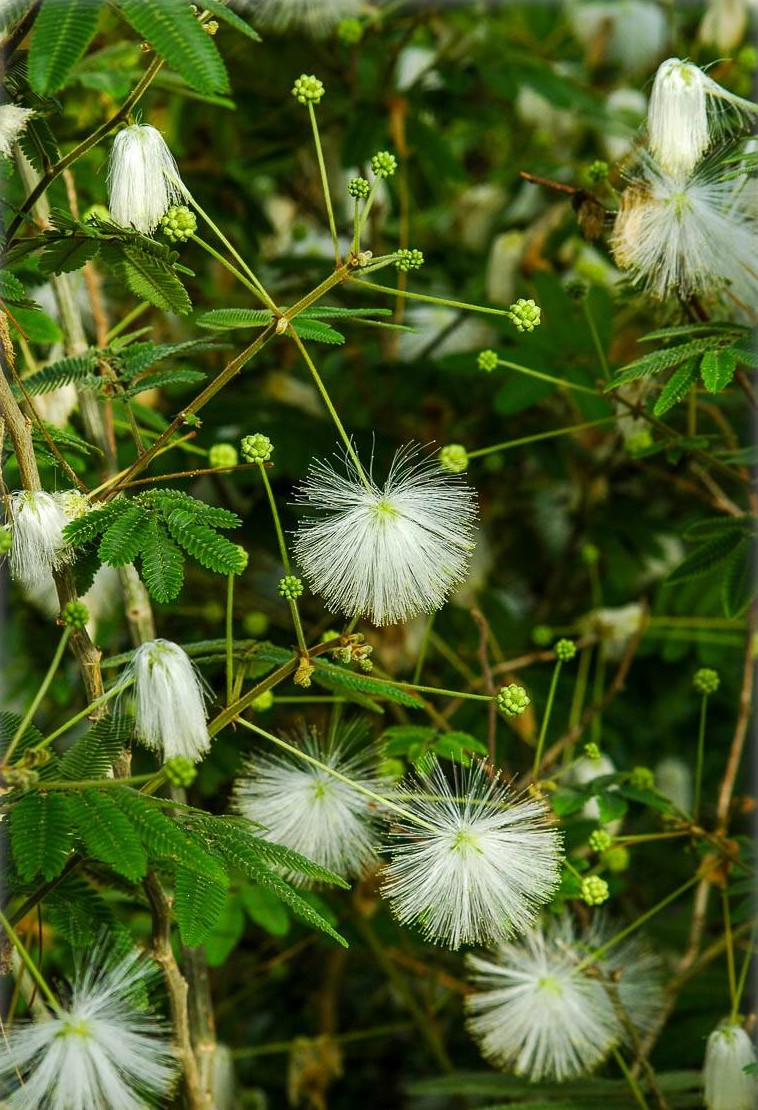Calliandra portoricensis

|
|
Calliandra portoricensis Common Names: Corpse Awakener, Powder Puff, Snowflake
Acacia, Puerto Rican Calliandra Scientific
Classification Kingdom: Plantae Phylum: Tracheophyta Class: Magnoliopsida Order: Fabales Family: Fabaceae Subfamily: Mimosoideae Genus: Calliandra Species: C. portoricensis Synonyms: Anneslia portoricensis (Jacq.) Don, Calliandra portoricensis var. multijuga Micheli, Mimosa portoricensis Jacq., Zapoteca portoricensis (Jacq.) H.M.Hern. Morphological Description Calliandra portoricensis, commonly known as Corpse Awakener or Powder Puff, is a small to
medium-sized evergreen shrub, typically growing 1–6 m tall, with a spreading
canopy. Its key features include: · Stem: Slender, terete, glabrous to slightly puberulous, with
brownish-grey bark · Leaves: Bipinnate, 5–15 cm long, with 2–4 pairs of pinnae, each
bearing 8–30 pairs of linear-oblong leaflets, 0.5–1 cm long, glossy green · Flowers: White to pink, 2–3 cm in diameter, in globose, fragrant
heads, with long, feathery stamens resembling pom-poms · Fruit: Linear pods, 5–10 cm long, flat, dehiscent, containing 4–8
dark brown seeds Distribution and Habitat Calliandra portoricensis is native to Puerto Rico and the West Indies, with
naturalized populations in Central America (Mexico, Panama), West Africa
(Nigeria, Ghana), and parts of Asia (India, Philippines). It thrives in: · Ecosystems: Tropical forests, forest edges, disturbed areas, and
roadsides · Climate: Tropical to subtropical, with rainfall of 1,000–2,500 mm
annually and temperatures of 20–35°C · Soils: Well-drained, loamy to sandy, tolerating moderate salinity · Altitude: Sea level to 1,200 m In Nigeria, it is
cultivated in southern states like Ogun and Osun, often in gardens and as a
hedge, and is considered invasive in some areas due to its rapid growth. Ethnopharmacology Calliandra portoricensis is a medicinal plant traditionally used in African herbal
medicine for a variety of health conditions. The roots, leaves, and bark are
valued for their anti-inflammatory, antimicrobial, antioxidant, analgesic,
antidiarrheal, and antifertility properties. Traditionally, root extracts are
used to manage inflammatory diseases, diarrhea, respiratory issues, and
pain-related disorders, while leaf preparations are sometimes applied to treat
skin infections and wounds. Research has shown that the plant contains
bioactive compounds such as flavonoids, alkaloids, tannins, saponins, and
terpenoids, which are believed to be responsible for its pharmacological
effects. In some studies, Calliandra portoricensis root extracts have also
demonstrated cytotoxic and antiproliferative activities, suggesting potential
for use in managing certain cancers. Despite its promising traditional uses,
further clinical research is needed to fully validate its safety and
therapeutic efficacy. · Anticonvulsant Activity: Aqueous
root and stem extracts (50 mg/kg) delayed pentylenetetrazole-induced seizures
in mice, validating their use for convulsions in Nigeria. The effect is linked
to non-alkaloidal compounds (Akah & Nwaiwu, 1988; Adesina & Akinwusi,
1984). · Antidiarrheal and Antispasmodic Effects: Leaf extracts inhibited intestinal motility in rats,
supporting their use for diarrhea in Nigeria. The antispasmodic effect is due
to anticholinergic properties (Aguwa & Lawal, 1988;). · Antisickling Properties: Methanol
leaf extracts inhibited sickle cell hemoglobin polymerization in vitro,
supporting their use for sickle cell anemia in Nigeria (Amujoyegbe et al.,
2014;). · Antioxidant and Antiproliferative Activities: Root methanol extracts scavenged DPPH radicals (IC₅₀
54.25 µg/mL) and inhibited PC-3 and LNCaP prostate cancer cell proliferation
(IC₅₀ 10–100 µg/mL), inducing apoptosis via Bax/Bcl-2 ratio alteration,
validating potential cancer therapy in Nigeria (Adaramoye et al., 2015;). · Antiparasitic Activity: Bokkosin,
a diterpene from root extracts, showed antiparasitic activity against Trypanosoma brucei brucei (EC₅₀ 0.69 µg/mL), supporting its use as an
anthelmintic in Nigeria (Nvau et al., 2020;). · Anti-ulcer Activity: Aqueous
leaf extracts (50 mg/kg) inhibited pylorus ligation-induced ulcers in rats by
60%, attributed to saponins and tannins, validating their use for
gastrointestinal disorders in Nigeria (Aguwa & Lawal, 1988;). · Antioxidant
and Free Radical Scavenging Activities: The ethyl acetate extract of Calliandra portoricensis root bark
exhibits significant antioxidant activity, effectively scavenging nitric oxide
and hydroxyl radicals. It also inhibits lipid peroxidation, suggesting
potential in mitigating oxidative stress-related conditions (Hassan et al.,
2013). · Analgesic
and Anti-inflammatory Effects: Methanolic extracts of the roots and leaves have demonstrated
dose-dependent analgesic activity in animal models, supporting traditional uses
for pain relief (Ofusori & Adejuwon, 2011). · Antimicrobial
Activity: The plant exhibits
antimicrobial properties against pathogens such as Staphylococcus aureus,
Streptococcus faecium, and Candida albicans, indicating potential as an
antimicrobial agent (Ese et al., 2022). · Reproductive
Health Benefits: In rodent models, root
bark extracts ameliorated oxidative and inflammatory damage in ovarian and
uterine tissues induced by chemical exposure, indicating potential benefits for
reproductive health (Adefisan et al., 2020). ⚠ Toxicity Profile: Calliandra portoricensis has moderate acute toxicity, with
intraperitoneal LD₅₀ values of 120.2 mg/kg (ethanolic leaf extract) and 79.4
mg/kg (aqueous leaf extract) in mice. Sub-chronic oral administration (4 mg/kg
for 28 days) caused disorganization of gastric mucosa and degeneration of
pancreatic islets of Langerhans in mice, indicating potential hepatotoxicity
and pancreatic toxicity. High doses may reduce sperm count in rats, suggesting
reproductive toxicity. The plant’s use as an abortifacient indicates potential
embryotoxicity. Traditional preparations (e.g., boiling) reduce risks, but
prolonged or high-dose use should be avoided, especially in pregnancy ( Enwuru
et al., 2017; Ofusori & Adejuwon, 2011; Ese et al., 2022). Additional Uses · Ornamental: The vibrant pom-pom flowers make it a popular ornamental
shrub in gardens and parks across Nigeria and the Caribbean. · Ecological Role: Nectar-rich flowers attract bees,
butterflies, and hummingbirds, enhancing pollination in tropical ecosystems . · Agricultural: Leaf extracts are used as molluscicides and ovicides in
Nigeria, controlling agricultural pests . References
External Links More Pictures |
|
| Compounds of Calliandra portoricensis | |
| References |